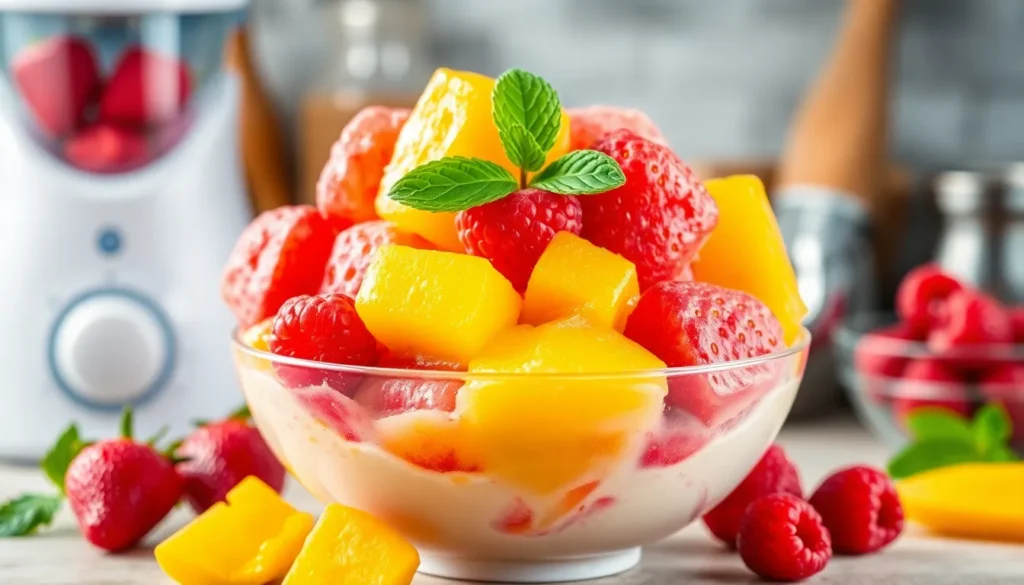Nothing beats the refreshing burst of a perfectly crafted sorbet on a warm day. We’ve discovered that making restaurant-quality sorbet at home isn’t just possible—it’s surprisingly simple and incredibly rewarding. These frozen treats offer a lighter alternative to ice cream while delivering intense fruit flavors that’ll make your taste buds sing.
From classic lemon and strawberry to exotic mango-passion fruit combinations, we’re about to share our favorite sorbet recipes that require minimal ingredients and equipment. You don’t need an expensive ice cream maker to create these silky-smooth desserts that’ll impress your family and guests.
The best part? Most sorbets contain just three basic ingredients: fruit, sugar, and water. We’ll guide you through foolproof techniques that guarantee perfectly textured results every time, plus share professional tips for achieving that coveted creamy consistency without any dairy.
Essential Equipment for Making Sorbet
Creating perfect sorbet at home requires surprisingly minimal equipment. We’ve tested various tools over the years and identified the essential items that make the biggest difference in achieving smooth and creamy results.
Ice Cream Maker stands as the most important piece of equipment for consistent sorbet texture. Churning action prevents large ice crystals from forming while incorporating air for a lighter mouthfeel. Electric models with built-in freezer bowls work exceptionally well for home use. Manual hand-crank versions also produce excellent results but require more effort.
High-Speed Blender or Food Processor handles fruit preparation and creates silky smooth purees. We recommend models with powerful motors that can easily break down frozen ingredients. Immersion blenders work as alternatives for smaller batches or softer fruits.
Fine-Mesh Strainer removes seeds and pulp for ultra-smooth textures. Seeds from berries or citrus can create unpleasant grittiness in the final product. Double straining through progressively finer meshes yields restaurant-quality results.
Digital Kitchen Scale ensures accurate ingredient ratios every time. Sorbet recipes depend on precise sugar-to-fruit ratios for proper freezing and texture. Volume measurements often lead to inconsistent results due to varying fruit densities.
Heavy-Bottomed Saucepan creates perfect simple syrups without hot spots or burning. Even heat distribution dissolves sugar completely and prevents crystallization. Stainless steel or enameled cast iron work best for this purpose.
Rubber Spatula helps scrape down blender sides and fold ingredients together without deflating air bubbles. Silicone varieties withstand temperature extremes better than traditional rubber.
Freezer-Safe Storage Containers with tight-fitting lids prevent ice crystals and freezer burn. Shallow containers freeze sorbet faster and make scooping easier. Glass or BPA-free plastic containers work equally well for storage.
Most home kitchens already contain these basic tools. Investing in quality equipment pays dividends in consistent results and easier preparation across multiple batches.
Basic Sorbet Base Recipe
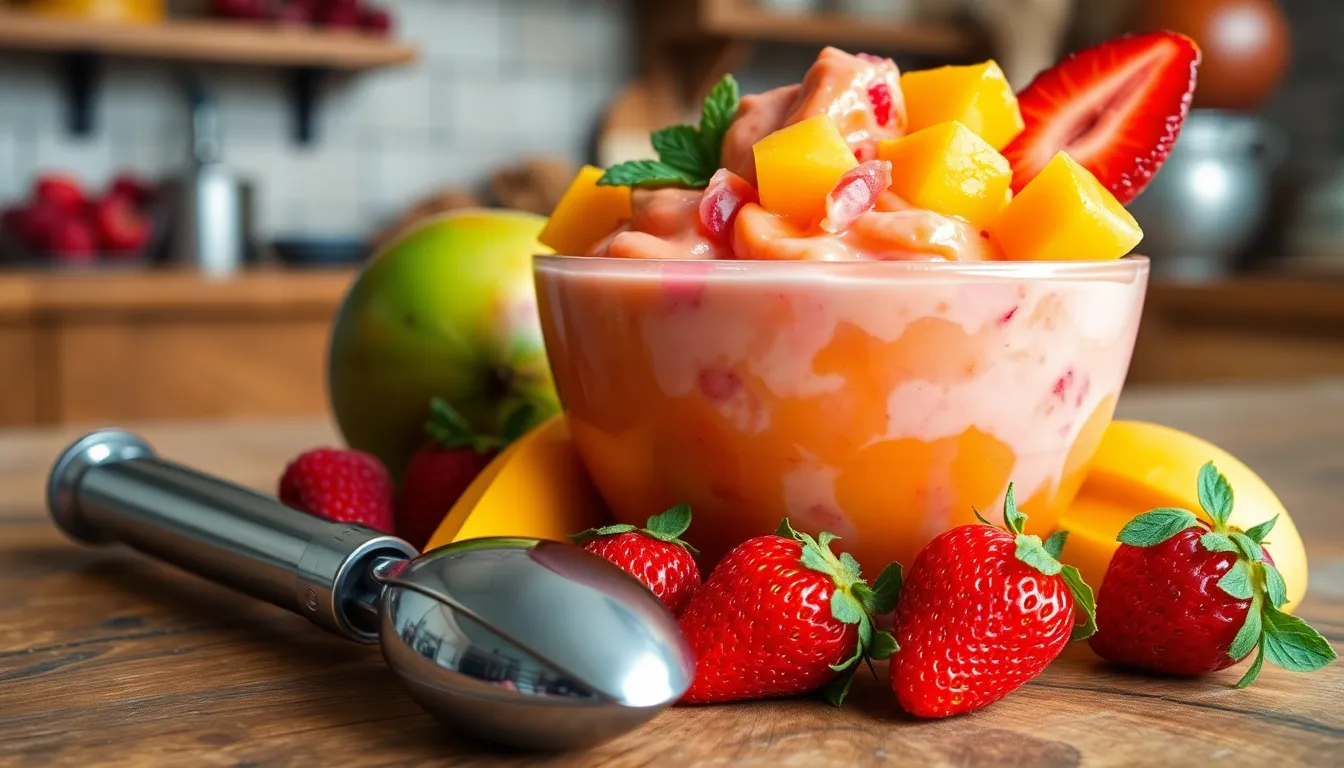
Our foundation recipe combines simple ingredients in perfect proportions to create a silky sorbet every time. The key lies in balancing sweetness with acidity to achieve that perfect frozen texture that melts beautifully on your tongue.
Simple Syrup Preparation
We start by creating a simple syrup that dissolves completely into our fruit base. Combine 1 cup granulated sugar and 1 cup water in a heavy-bottomed saucepan.
Heat the mixture over medium heat while stirring continuously until the sugar completely dissolves. The liquid should appear clear without any granules remaining. Allow the syrup to cool to room temperature before incorporating it into your sorbet base.
This preparation method ensures even sweetness distribution throughout your final product. We recommend making extra simple syrup since it stores well in the refrigerator for up to one month.
Fruit Puree Method
Select ripe fruits like raspberries, strawberries, or mangoes for the most vibrant flavor profiles. The ripeness directly impacts the natural sweetness and reduces the need for additional sugar adjustments.
Blend your chosen fruit into a smooth purée using a high-speed blender or food processor. Process until completely smooth with no visible chunks remaining. For fruits with seeds like raspberries or blackberries, strain the mixture through a fine-mesh strainer to achieve that ultra-smooth texture we discussed earlier.
Mix the fruit purée with 1 cup of sugar per 4 cups of purée as our base ratio. You can substitute simple syrup for granulated sugar if you prefer more consistent sweetness distribution.
| Ingredient | Amount |
|---|---|
| Fruit purée | 4 cups |
| Sugar | 1 cup |
| Water | 2-4 tablespoons |
Refrigerate the mixture until it reaches a temperature between 38°F and 40°F before churning. This chilling step prevents the ice cream maker from working too hard and ensures smoother texture development.
Use your ice cream maker according to manufacturer instructions or freeze the mixture in a container. If using the container method, stir every 30 minutes until the sorbet reaches a firm but scoopable consistency.
Classic Fruit Sorbet Recipes
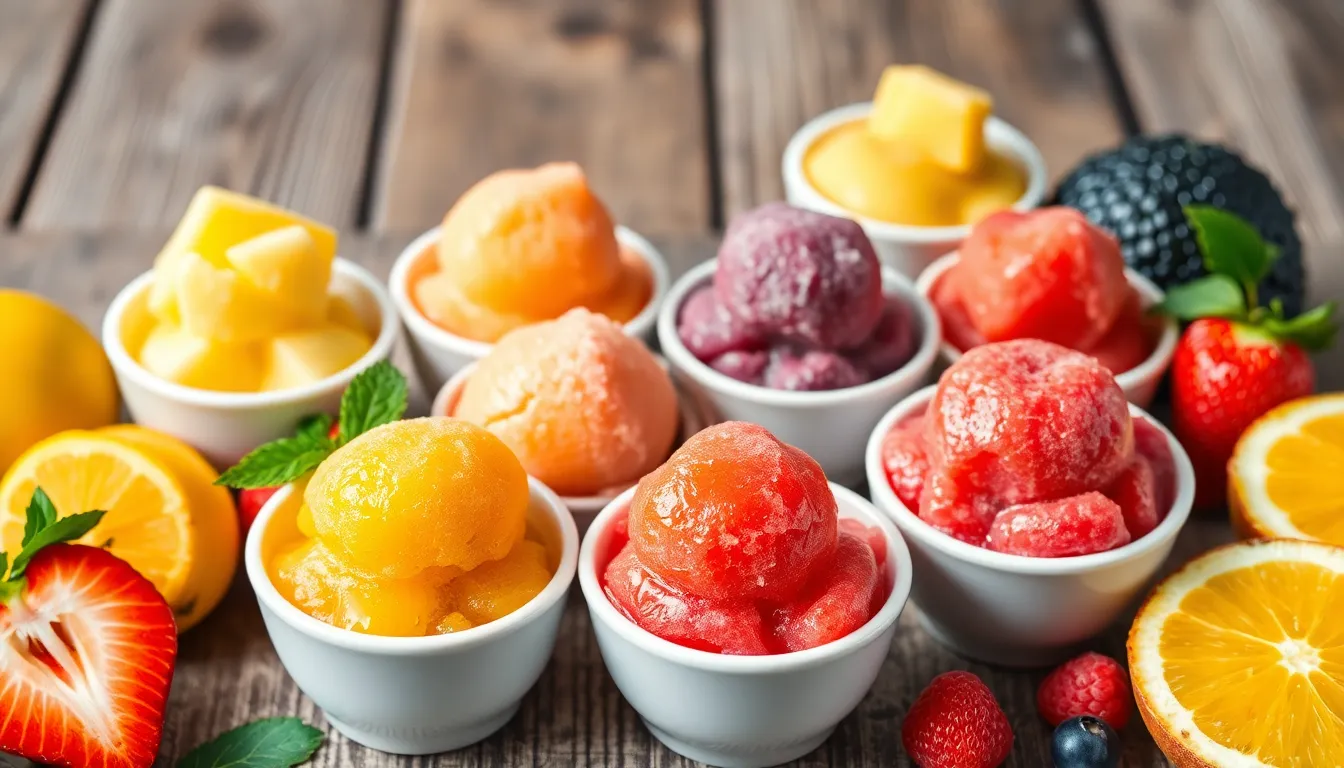
We’ve curated these time-tested fruit sorbet recipes that showcase the pure essence of seasonal fruits. Each recipe delivers intense flavors with remarkably smooth textures.
Lemon Sorbet
Ingredients:
- 4 cups freshly squeezed lemon juice
- 1 cup sugar
- 2 cups water
Combine lemon juice, sugar, and water in a heavy-bottomed saucepan. Heat the mixture over medium heat while stirring until the sugar completely dissolves. Remove from heat and allow the mixture to chill completely in the refrigerator.
Pour the chilled mixture into your ice cream maker and churn according to the manufacturer’s instructions. Transfer the churned sorbet to a freezer-safe container and freeze until firm. The bright acidity balances perfectly with the sweetness to create this classic palate cleanser.
Strawberry Sorbet
Ingredients:
- 4 cups strawberries, pureed
- Sugar to taste
- Lemon juice (optional)
Puree fresh strawberries in a high-speed blender until completely smooth. Combine the strawberry puree with sugar and a splash of lemon juice if desired for enhanced flavor balance. Blend the mixture until all sugar dissolves completely.
Pour the prepared mixture into your ice cream maker and churn until it reaches the proper consistency. Freeze in a covered container until firm. We recommend straining the mixture through a fine-mesh sieve before churning to remove any remaining seeds for an ultra-smooth texture.
Mango Sorbet
Ingredients:
- 4 cups mango puree
- Sugar to taste
- Lime juice (optional)
Select perfectly ripe mangoes and puree them until silky smooth. Mix the mango puree with sugar and a touch of lime juice if you prefer a more complex flavor profile. Ensure all sugar granules dissolve completely by blending thoroughly.
Follow the same churning and freezing process as the previous recipes. The natural sweetness of ripe mangoes often requires less added sugar than other fruit sorbets.
Raspberry Sorbet
Ingredients:
- 8 oz raspberries (by weight)
- 3-4 tbsp sugar syrup or maple syrup
- Lemon juice (optional)
Blend the raspberries into a smooth puree using your food processor or high-speed blender. Mix the puree with sugar syrup or maple syrup and add lemon juice if desired for brightness. This recipe offers a refined sugar-free option by using natural sweeteners like agave nectar or maple syrup.
Strain the mixture through a fine-mesh sieve to remove all seeds before churning. The strained mixture will produce an exceptionally smooth sorbet that highlights the intense raspberry flavor without any textural distractions.
Creative Flavor Combinations
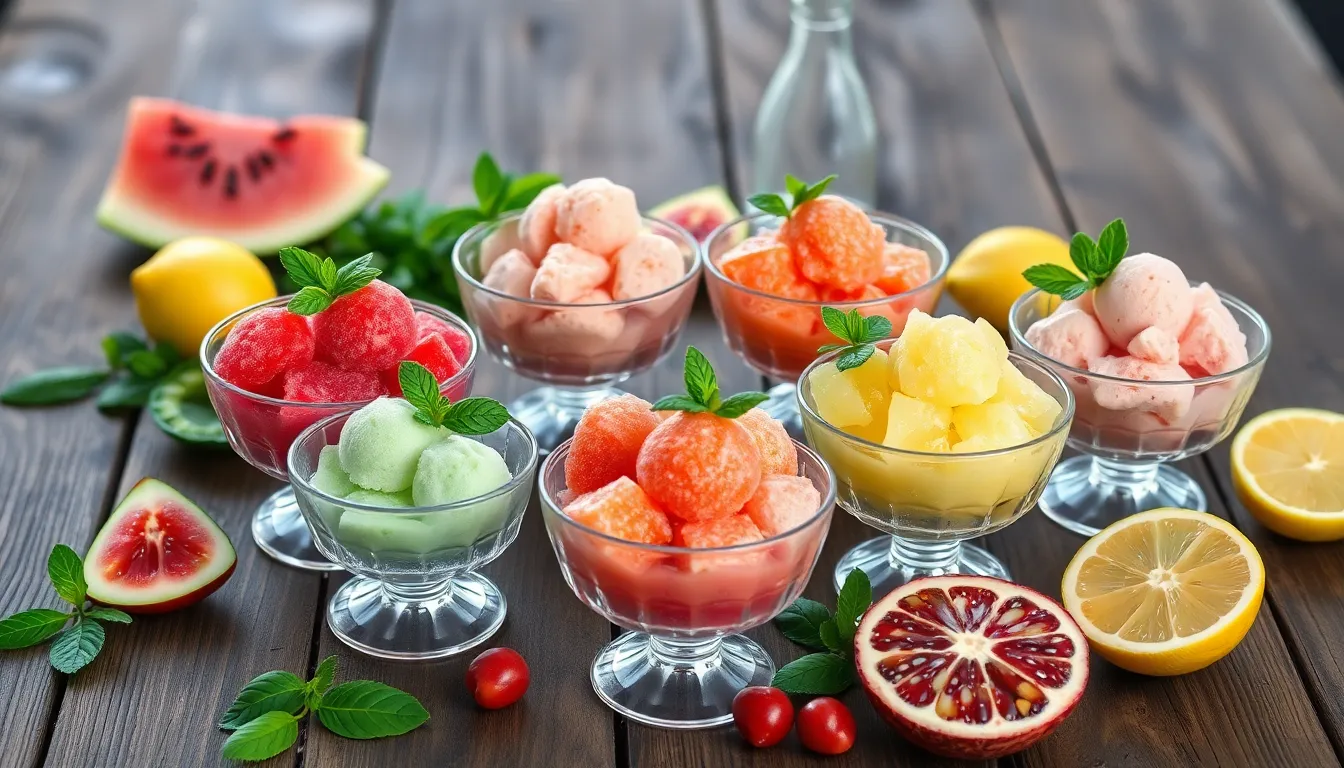
Once you’ve mastered the classic fruit sorbets, it’s time to explore unique combinations that elevate this frozen dessert to new heights. These innovative pairings blend unexpected ingredients to create memorable flavors that will surprise and delight your guests.
Watermelon Basil Sorbet
This refreshing summer combination marries the natural sweetness of watermelon with aromatic basil for a sophisticated frozen treat. We love how the herb’s subtle peppery notes complement the fruit’s clean taste.
Ingredients:
- 4 cups cubed seedless watermelon
- 1/2 cup granulated sugar
- 1/4 cup water
- 2 tablespoons fresh lime juice
- 8 fresh basil leaves
- Pinch of salt
Instructions:
Combine sugar and water in a small saucepan over medium heat. Stir until sugar dissolves completely to create a simple syrup. Remove from heat and add basil leaves. Let steep for 15 minutes then strain out the herbs.
Puree watermelon in a blender until completely smooth. Add the basil simple syrup, lime juice, and salt. Blend briefly to combine all ingredients.
Strain the mixture through a fine mesh sieve to remove any pulp. Chill in refrigerator for at least 2 hours before churning in your ice cream maker according to manufacturer’s instructions.
Cucumber Mint Sorbet
This cooling combination transforms ordinary cucumbers into an elegant palate cleanser perfect for hot summer evenings. The refreshing duo creates a light dessert that feels both familiar and exotic.
Ingredients:
- 3 large English cucumbers, peeled and chopped
- 3/4 cup granulated sugar
- 1/2 cup water
- 1/4 cup fresh lemon juice
- 1/4 cup fresh mint leaves
- 1/4 teaspoon salt
Instructions:
Create mint simple syrup by heating water and sugar in a saucepan until sugar dissolves. Add mint leaves and steep for 20 minutes. Strain to remove all plant matter.
Puree cucumbers in a food processor until smooth. Add the mint syrup, lemon juice, and salt. Process until well combined.
Pass the mixture through a fine strainer to achieve an ultra smooth texture. Refrigerate for 2 hours before churning in ice cream maker until set.
Pineapple Jalapeño Sorbet
Sweet tropical pineapple meets spicy jalapeño heat in this bold sorbet that awakens every taste bud. We adjust the pepper quantity based on desired heat level for a customized kick.
Ingredients:
- 4 cups fresh pineapple chunks
- 2/3 cup granulated sugar
- 1/3 cup water
- 2 tablespoons fresh lime juice
- 1-2 jalapeño peppers, seeded and minced
- Pinch of salt
Instructions:
Heat sugar, water, and minced jalapeño in a small saucepan over medium heat. Stir until sugar dissolves then simmer for 5 minutes to infuse the spice. Cool completely and strain if desired for less heat.
Blend pineapple chunks until completely smooth. Add the jalapeño simple syrup, lime juice, and salt. Process until evenly mixed.
Strain the mixture to remove any remaining pulp or pepper pieces. Chill thoroughly before churning in ice cream maker according to device instructions.
Pomegranate Lime Sorbet
Tart lime juice balances the deep fruity sweetness of pomegranate in this vibrant ruby colored sorbet. The combination creates a dessert that’s both refreshing and intensely flavorful.
Ingredients:
- 2 cups pomegranate juice
- 1/2 cup granulated sugar
- 1/4 cup water
- 1/4 cup fresh lime juice
- 1 tablespoon lime zest
- Pinch of salt
Instructions:
Dissolve sugar in water over medium heat to create simple syrup. Cool to room temperature before proceeding with the recipe.
Combine pomegranate juice, cooled simple syrup, lime juice, lime zest, and salt in a large bowl. Whisk until all ingredients are well incorporated.
Strain the mixture through a fine mesh sieve to remove zest pieces if desired. Chill for at least 1 hour before churning in ice cream maker until frozen solid.
Wine and Cocktail-Inspired Sorbets
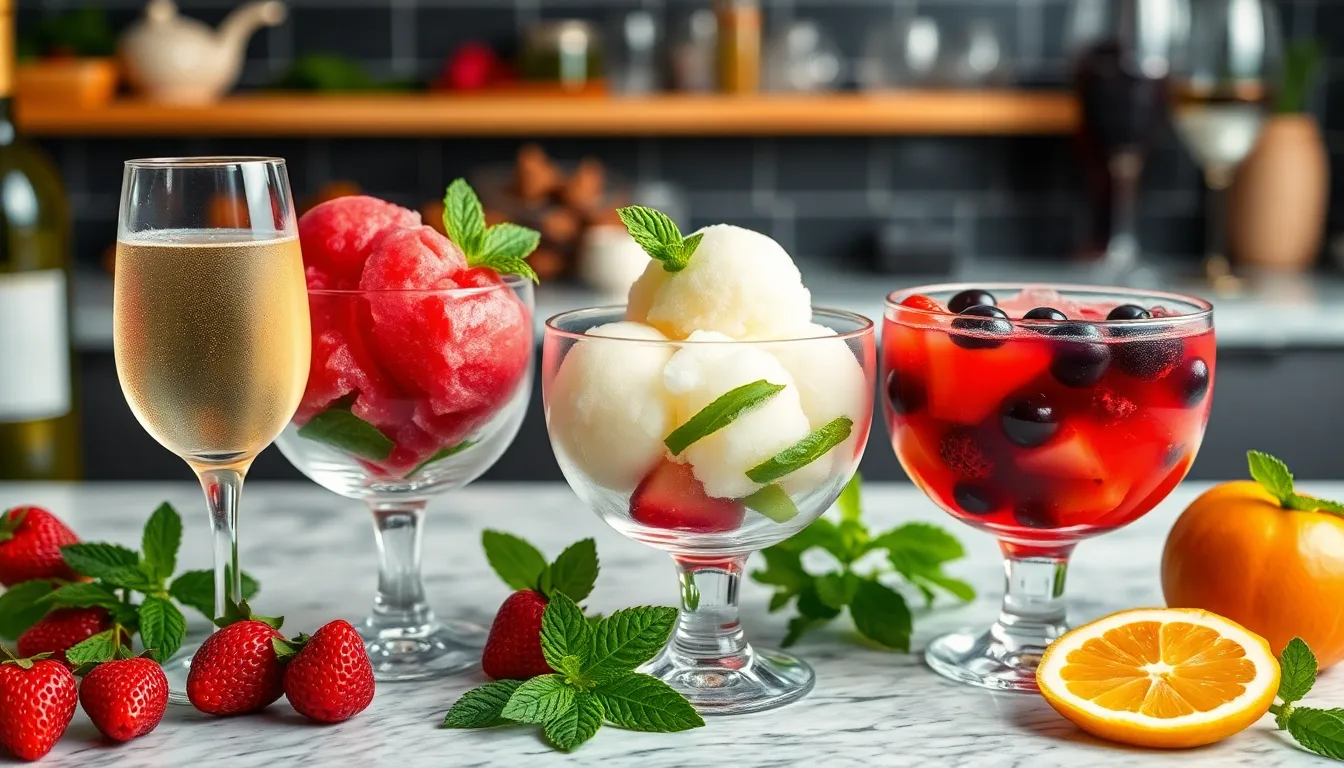
We can elevate our sorbet game by incorporating wine and cocktail flavors that bring sophisticated adult appeal to these frozen treats. These alcohol-infused sorbets capture the essence of our favorite drinks while maintaining the refreshing qualities we love about traditional fruit sorbets.
Prosecco Sorbet
This elegant sparkling wine sorbet brings celebration to every spoonful with its light effervescence and crisp finish.
Ingredients:
- 2 cups Prosecco
- 1 cup granulated sugar
- Water (optional for dilution)
Instructions:
- Prepare the base mixture by combining Prosecco and sugar in a medium saucepan over medium heat
- Dissolve the sugar completely by stirring continuously until the mixture becomes clear and no granules remain
- Cool the mixture by removing from heat and allowing it to reach room temperature
- Chill thoroughly in the refrigerator for at least 2 hours until completely cold
- Churn the sorbet by pouring the mixture into your ice cream maker and processing according to manufacturer instructions
- Final freeze for at least 2 hours in a freezer-safe container to achieve proper scooping consistency
Mojito Sorbet
We transform the classic Cuban cocktail into a refreshing frozen dessert that balances rum with bright lime and cooling mint.
Ingredients:
- 1 cup white rum
- 1 cup freshly squeezed lime juice
- 1 cup simple syrup
- 1 cup chopped fresh mint leaves
Instructions:
- Blend the liquid base by combining rum, lime juice, and simple syrup in a high-speed blender
- Add fresh mint and blend until the mixture becomes completely smooth and vibrant green
- Strain the mixture through a fine-mesh strainer into a bowl to remove any remaining mint pieces
- Chill completely in the refrigerator for at least 2 hours
- Process in ice cream maker according to manufacturer directions until thick and creamy
- Freeze until firm for at least 2 hours before serving
Sangria Sorbet
Our sangria sorbet captures the fruity complexity of the beloved Spanish drink with a medley of wine and mixed berries.
Ingredients:
- 1½ cups red wine blend
- 3 cups frozen mixed berries (strawberries, blueberries, raspberries)
- 2½ tablespoons honey
- Freeze the wine base by pouring red wine into ice cube trays and freezing until solid
- Combine frozen elements by adding frozen wine cubes, frozen berries, and honey to a high-speed blender
- Blend until smooth while maintaining some texture from the fruit pieces
- Taste and adjust sweetness by adding more honey if needed
- Transfer to container and freeze for additional firmness if a harder texture is desired
- Serve immediately or store in freezer-safe containers for up to one week
Ingredients

We believe the secret to exceptional sorbet lies in selecting the right ingredients that complement each other perfectly. Our approach focuses on three key categories that work together to create deliciously smooth and flavorful frozen treats.
Fresh Fruits
Fresh fruits form the foundation of any great sorbet recipe. We recommend using strawberries for their natural sweetness and vibrant color that creates stunning pink sorbets. Mangoes deliver tropical richness and natural creaminess that requires minimal additional ingredients. Raspberries provide intense flavor and beautiful ruby hues while offering the perfect balance of sweet and tart notes.
Lemons serve as both primary flavor and acidic component in citrus sorbets. Pineapple brings tropical sweetness with natural enzymes that help create smooth textures. We always select fruits at peak ripeness to ensure maximum flavor concentration and natural sugar content.
Sweeteners
Simple syrup stands as our preferred sweetening method because it distributes evenly throughout the mixture. Regular granulated sugar works perfectly for most recipes and dissolves completely when properly prepared. Agave nectar offers a liquid sweetener option that blends seamlessly with fruit purees.
Maple syrup adds depth and complexity to certain fruit combinations. Sugar syrup provides consistent sweetness levels and prevents crystallization during the freezing process. We recommend preparing sweeteners ahead of time to ensure they reach proper temperature before mixing with other ingredients.
Flavor Enhancers
Lemon juice serves multiple purposes by improving natural fruit flavors and adding necessary acidity for proper texture. Fresh lemon juice prevents oxidation and brightens overall taste profiles across all sorbet varieties. Citrus juices like orange juice complement tropical fruits and add natural vitamin C content.
Vodka acts as a texture modifier that prevents sorbets from freezing too solid while maintaining smoothness. Gin creates sophisticated flavor profiles when paired with citrus elements. Liquors should be used sparingly to maintain proper freezing consistency while adding subtle complexity to adult oriented recipes.
Instructions
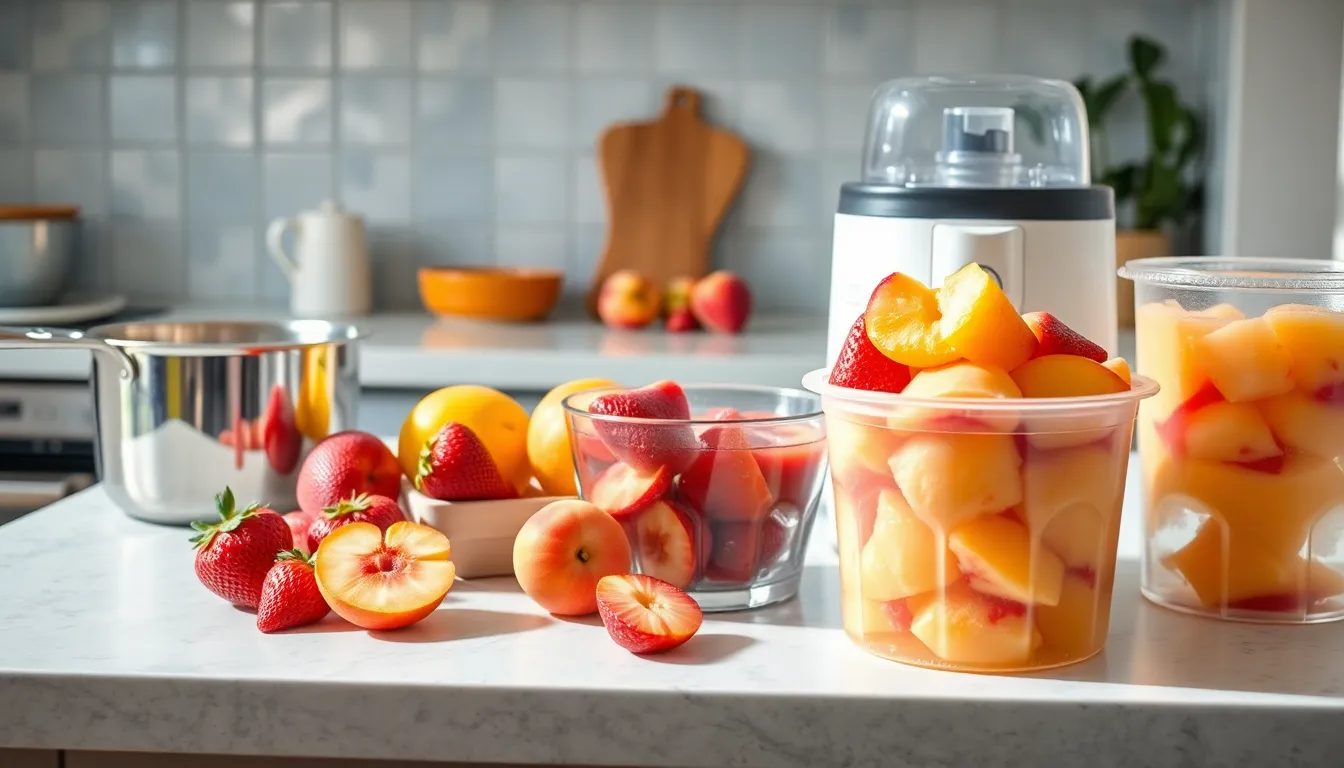
Now that we have our ingredients and equipment ready, let’s walk through the essential steps to create perfectly smooth and flavorful sorbet. Following these detailed instructions will ensure consistent results every time.
Prep Work
We begin by selecting approximately 5 cups of chopped fruit to yield 4 cups of purée, though this amount varies depending on the fruit’s density. Fresh fruit preparation requires washing and removing any stems, pits, or tough skins before chopping into uniform pieces.
Our simple syrup preparation combines 1 cup of water and 1 cup of sugar in a saucepan over medium heat. We stir the mixture continuously until the sugar dissolves completely, then remove it from heat and allow it to cool to room temperature. This syrup ensures even sweetness distribution throughout our sorbet base.
Mixing the Base
We start with 1 cup of fruit juice or purée as our foundation. Adding 1/4 cup of simple syrup creates the initial sweetness balance, but we need to test and adjust this ratio carefully.
The floating egg test helps us achieve the perfect sugar balance for optimal texture. We place a clean raw egg in the mixture and add simple syrup one tablespoon at a time until the egg floats with approximately a quarter-sized portion of its shell exposed above the surface. This technique ensures our sorbet won’t freeze too hard or remain too soft.
Churning Process
An ice cream maker provides the most consistent results when available. We pour our chilled mixture into the machine and churn according to the manufacturer’s instructions, typically 20 to 25 minutes.
For the no-churn method, we freeze the mixture in a shallow metal pan until solid, approximately 4 to 6 hours. Once frozen, we break the mixture into chunks and blend in a food processor until smooth and creamy. This process may require scraping down the sides several times to achieve uniform texture.
Freezing and Storage
We transfer the churned sorbet to an airtight container and freeze for at least 2 hours to firm up completely. Proper storage requires maintaining freezer temperatures at 0°F (-18°C) or below for optimal texture and flavor preservation.
Our finished sorbet typically lasts several weeks when stored properly in airtight containers. We recommend placing plastic wrap directly on the surface before sealing to prevent ice crystal formation and freezer burn.
Make-Ahead Tips
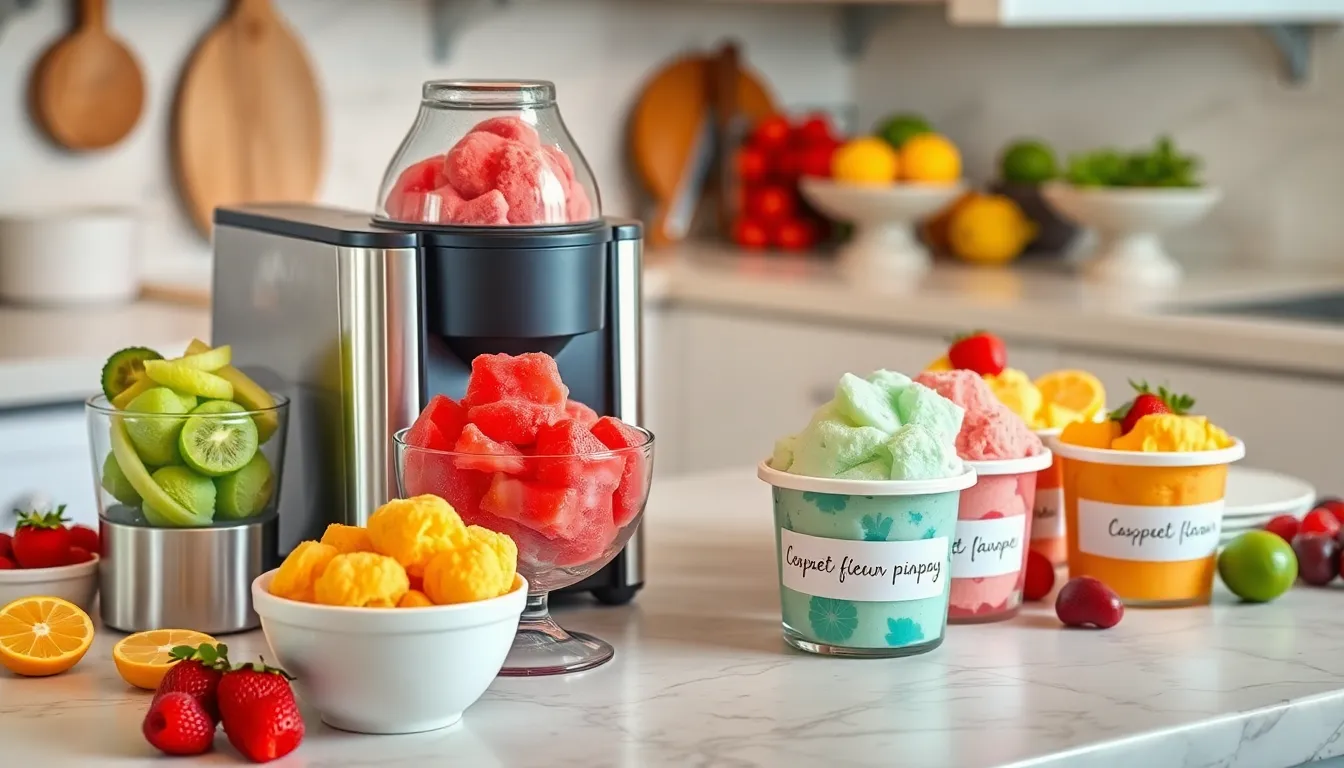
Preparing sorbet in advance transforms this delightful dessert into a stress-free entertaining option. We recommend making our sorbet recipes up to three months ahead of time since homemade sorbet maintains its quality beautifully when stored properly in the freezer.
Freezer Canister Preparation
Our ice cream maker requires advance planning for optimal results. We always freeze the canister 12 to 24 hours before churning to ensure it reaches the proper temperature. This step prevents disappointing results and guarantees smooth texture development during the churning process.
Batch Storage Guidelines
| Storage Duration | Quality Level | Best Uses |
|---|---|---|
| 1-2 weeks | Peak flavor and texture | Daily desserts and casual entertaining |
| 1-2 months | Excellent quality | Dinner parties and special occasions |
| Up to 3 months | Good quality | Emergency desserts and bulk preparation |
Pre-Service Preparation
We always remove sorbet from the freezer 10 to 15 minutes before serving to allow slight thawing. This technique makes scooping effortless and prevents the frustration of rock-hard frozen dessert. The texture becomes perfectly creamy without losing its refreshing frozen quality.
Make-Ahead Serving Strategy
Planning large gatherings becomes seamless when we prepare multiple sorbet flavors weeks in advance. We label each container with the flavor and preparation date to track freshness. Different flavors can be made on separate days to distribute the workload while maintaining peak quality for each variety.
Simple Syrup Batch Preparation
We often prepare large batches of simple syrup to streamline multiple sorbet recipes. Extra syrup stores in the refrigerator for up to one month and eliminates repetitive preparation steps when making various flavors throughout the season.
Serving Suggestions
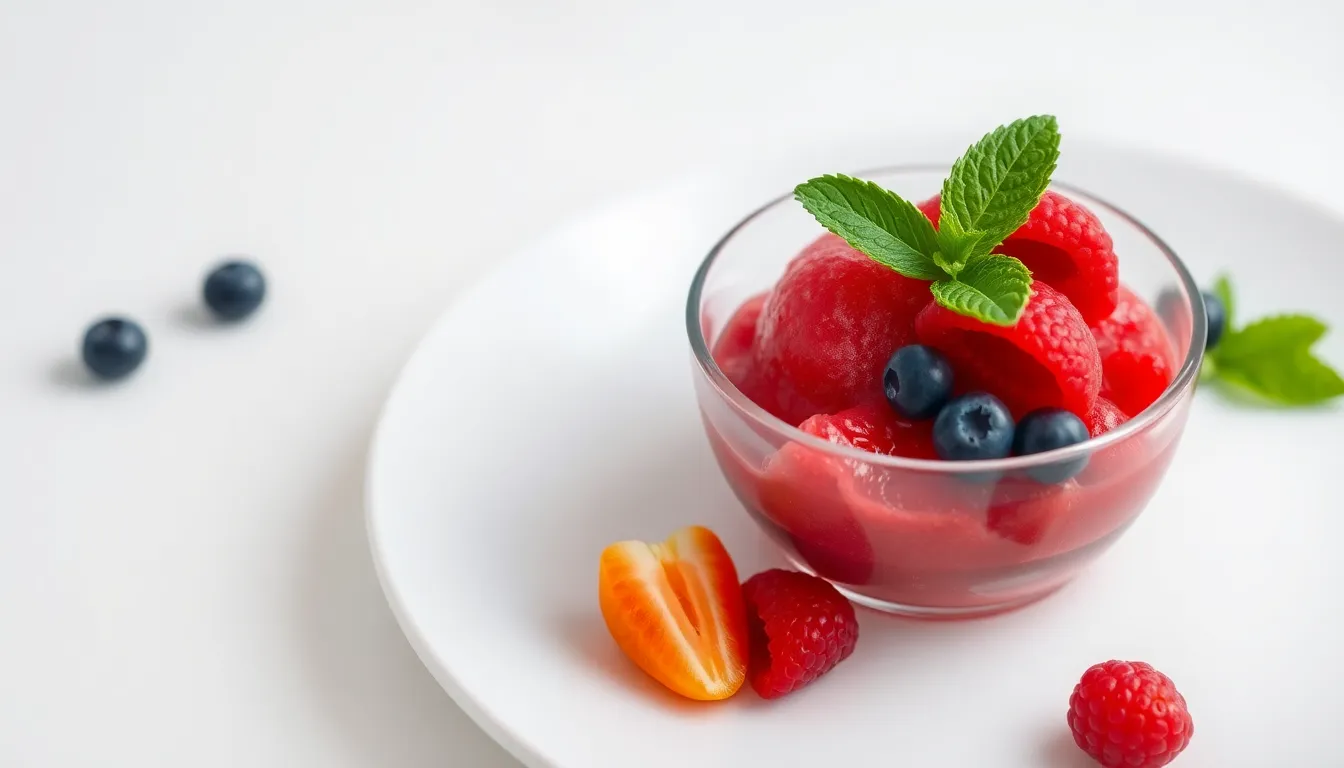
We’ve mastered the art of creating perfect sorbet at home. Now let’s explore presentation techniques and pairing strategies that transform our frozen creations into restaurant-quality desserts.
Garnish Ideas
Fresh Fruit Garnishes add vibrant color and complementary flavors to our sorbet presentations. We recommend garnishing with sliced strawberries or kiwi for visual appeal and enhanced taste [5]. Berries work exceptionally well with citrus sorbets while tropical fruits pair beautifully with our mango or pineapple varieties.
Edible Containers create stunning natural presentations that wow guests. Serving sorbet in hollowed-out fruit shells like lemons or oranges provides an elegant and eco-friendly presentation option [3]. Orange shells work particularly well with citrus sorbets while coconut shells complement tropical flavors perfectly.
Textural Elements provide delightful contrast to our smooth sorbets. Adding tuiles and small cookies enhances the eating experience with satisfying crunch [4]. We love pairing delicate almond tuiles with berry sorbets or shortbread cookies with lemon varieties.
Nuts and Seeds offer another layer of texture and flavor complexity. Sprinkling chopped pistachios over raspberry sorbet or toasted coconut flakes on mango sorbet creates memorable taste combinations [5]. Pine nuts work beautifully with citrus varieties while candied almonds complement wine-based sorbets.
Herb Garnishes add sophisticated aromatic elements to our presentations. Fresh mint sprigs work universally well with most fruit sorbets while basil leaves create striking presentations with watermelon or strawberry varieties.
Pairing Recommendations
Fresh Fruit Platters create colorful and refreshing dessert presentations that showcase seasonal produce. We combine different fruits to create visually stunning arrangements that complement our sorbet flavors naturally.
Chocolate Pairings offer rich contrast to our light frozen treats. Pairing sorbet with chocolate truffles creates an elegant dessert experience that balances refreshing fruit flavors with decadent chocolate richness.
Coffee and Tea Service positions sorbet as an ideal palate cleanser between beverages and other desserts. We serve small portions of citrus or herb-infused sorbets to refresh the palate during multi-course meals.
Wine Accompaniments elevate our sorbet service for sophisticated entertaining. Light dessert wines complement fruit sorbets beautifully while sparkling wines pair exceptionally well with our citrus varieties.
| Sorbet Flavor | Best Pairing | Serving Temperature |
|---|---|---|
| Lemon | Shortbread cookies | -5°F to 0°F |
| Berry varieties | Chocolate truffles | -5°F to 0°F |
| Tropical fruits | Coconut tuiles | -5°F to 0°F |
| Wine-based | Fresh berries | -5°F to 0°F |
Temperature Control ensures optimal texture and flavor presentation. We maintain sorbet at the proper serving temperature to preserve its creamy consistency and intense fruit flavors.
Timing Guidelines maximize garnish impact and visual appeal. Adding garnishes just before serving prevents them from becoming soggy or losing their texture while maintaining the professional presentation we’ve worked to achieve.
Troubleshooting Common Issues
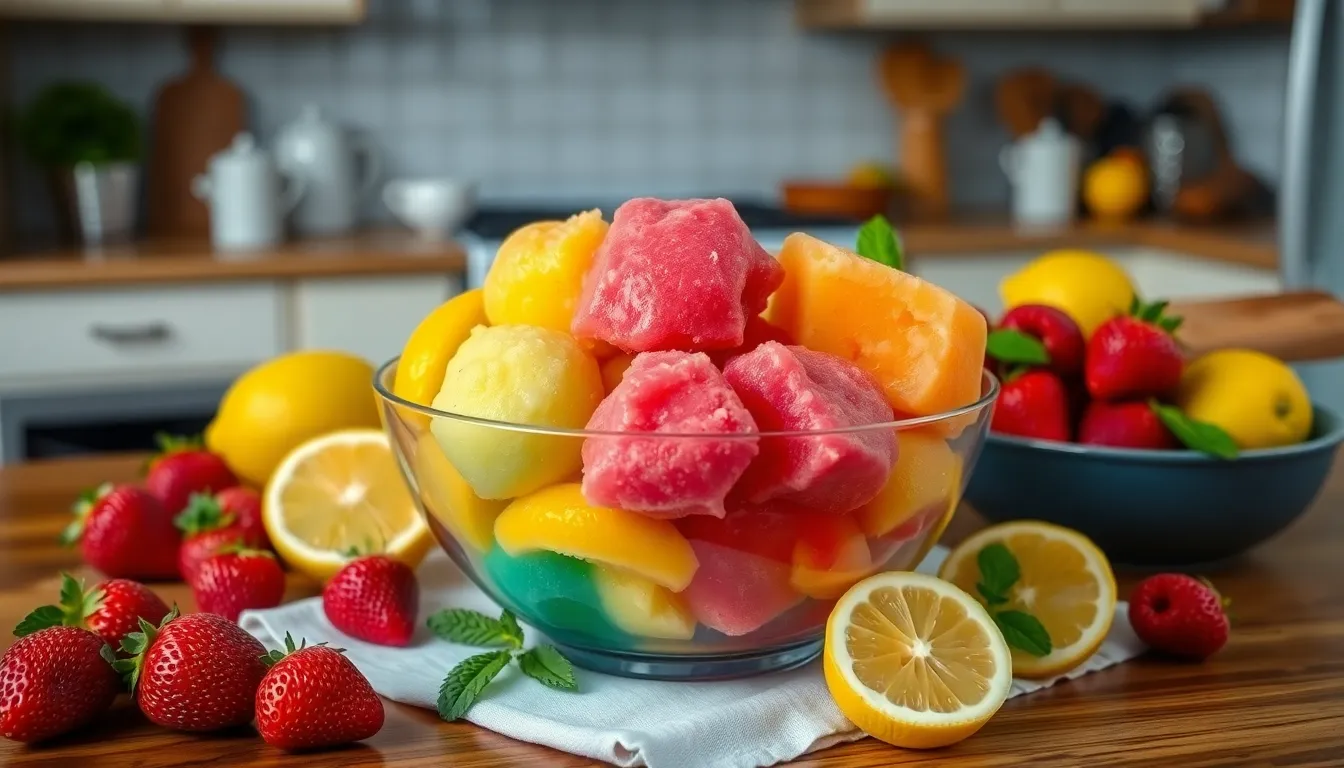
Even experienced home cooks encounter challenges when making sorbet. We’ll help you identify and solve the most common problems to ensure perfect results every time.
Texture Problems
Too Icy: This happens when your sorbet lacks sufficient sugar content. Add more sugar until satisfied with the texture and re-churn the mixture. The sugar acts as an antifreeze agent that prevents large ice crystals from forming.
Too Slushy: Your mixture contains too much liquid or insufficient fruit solids. Add more fruit puree to thicken the base or reduce the sugar content to achieve the proper consistency. This imbalance often occurs when we add too much water or simple syrup.
Separation: When ingredients separate during freezing, the mixture wasn’t properly combined before chilling. Whisk the mixture thoroughly before chilling and churning to ensure all components are fully integrated. This creates a stable emulsion that won’t break apart during the freezing process.
We recommend chilling your mixture to 40°F or lower before churning for optimal texture results. Using an ice cream maker according to the manufacturer’s directions will give you the best consistency every time.
Flavor Balance
Too Sweet: Balance overly sweet sorbet by adding more lemon juice, water, or fresh fruit to cut through the sweetness. Citrus juice works particularly well because it adds both acidity and brightness to counteract excessive sugar.
Underseasoned: When your sorbet tastes flat or lacks depth, add more salt and re-churn the mixture. Salt enhances fruit flavors and brings out the natural sweetness without making the sorbet taste salty.
If problems persist after making adjustments, let the sorbet melt completely, modify the recipe according to our guidelines, and re-churn the mixture. This second chance approach often yields better results than trying to fix issues in already-frozen sorbet.
Storage and Shelf Life
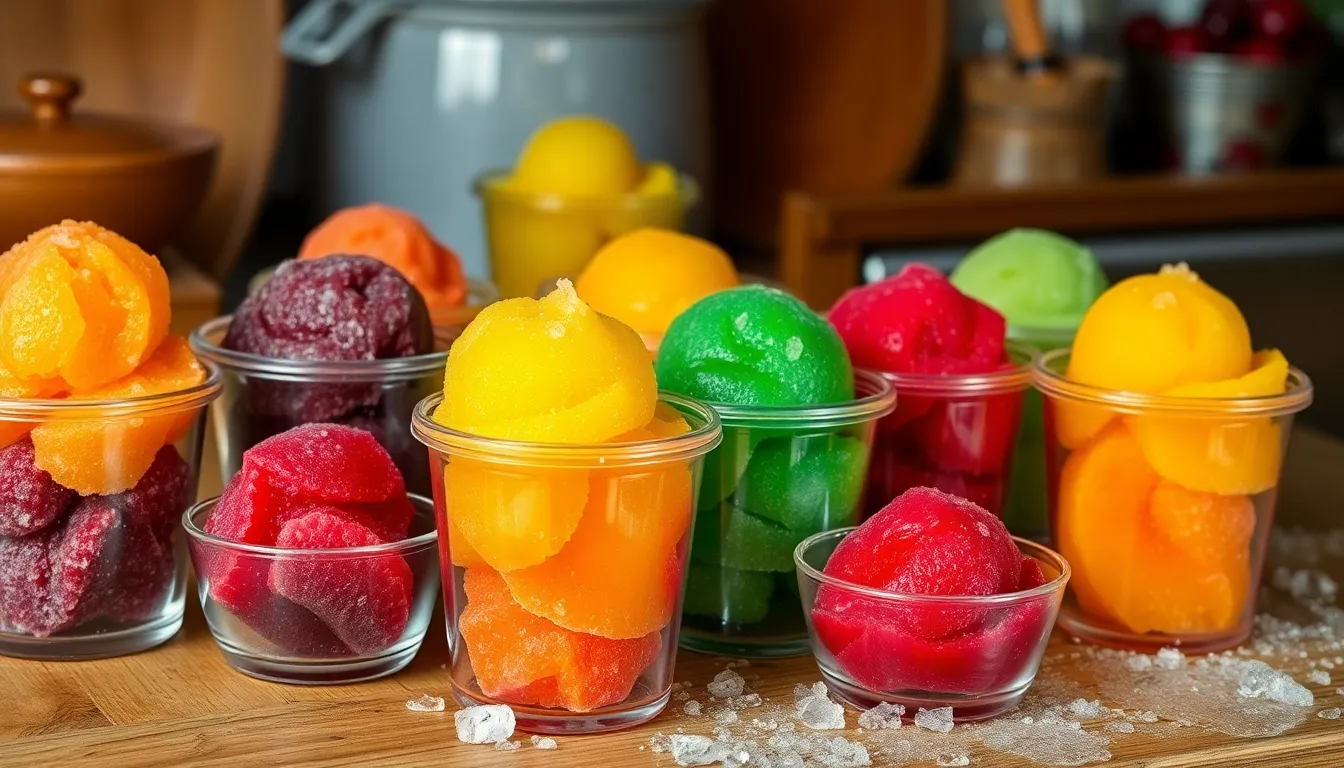
Proper storage becomes crucial once we create our perfect sorbet. We must store sorbet in the freezer at a constant temperature of 0°F (-18°C) or colder to maintain its quality and texture. Temperature fluctuations can accelerate quality decline and affect the smooth consistency we worked so hard to achieve.
Proper Storage Techniques
We recommend keeping sorbet in airtight containers or resealable plastic bags to prevent ice crystal formation and freezer burn. These storage methods protect our homemade creations from absorbing unwanted freezer odors while maintaining their vibrant flavors. Airtight sealing prevents moisture from entering the container and creating those unwanted ice crystals that can ruin the texture.
Shelf Life Guidelines
Different types of sorbet have varying shelf life expectations based on their preparation and storage conditions:
| Sorbet Type | Optimal Quality Period | Maximum Safe Period |
|---|---|---|
| Unopened store-bought | 6-8 months | Up to 1 year |
| Opened store-bought | 2-4 months | 6 months |
| Homemade sorbet | 1 month | 3 months |
| Unfrozen sorbet mix | 48 hours in refrigerator | 48 hours |
Our homemade sorbets taste best within the first month of preparation. Quality remains excellent during this timeframe when we store them correctly. Commercial varieties may last longer due to added stabilizers and preservatives that extend their shelf life beyond what we can achieve at home.
Factors Affecting Longevity
Sugar content plays a important role in extending sorbet shelf life. The sugar acts as a natural preservative and prevents the sorbet from freezing into a solid block. Higher sugar content generally means longer storage life and better texture maintenance over time.
We should always follow manufacturer “best by” dates for store-bought products. These dates indicate peak quality rather than safety expiration. Sorbet remains safe to eat beyond these dates if stored correctly though flavor and texture may decline.
Storage Best Practices
Unfrozen sorbet mix can be stored in the refrigerator for up to 48 hours before churning. This flexibility allows us to prepare our base mixture ahead of time for convenient batch processing. We must avoid repeatedly thawing and refreezing sorbet as this degrades quality and creates undesirable ice crystals.
Store-bought varieties typically last longer than our homemade versions due to commercial stabilizers. But our fresh homemade sorbets offer superior flavor and satisfaction when consumed within their optimal timeframe.
Conclusion
Making sorbet at home is simpler than you might think and infinitely more rewarding than store-bought alternatives. With just a few basic ingredients and the right techniques we’ve shared you’ll create frozen desserts that rival any restaurant.
Whether you stick to classic fruit flavors or venture into creative combinations like watermelon basil or prosecco sorbet the possibilities are endless. The key is using quality ingredients and following proper preparation methods.
We encourage you to start with our basic recipes and then experiment with your favorite fruits and flavors. Soon you’ll discover that homemade sorbet isn’t just a dessert – it’s a delicious way to showcase seasonal produce and impress your guests with minimal effort.
Frequently Asked Questions
What equipment do I need to make homemade sorbet?
The essential equipment includes an ice cream maker for consistent texture, a high-speed blender or food processor for smooth purees, and a fine-mesh strainer to remove seeds. You’ll also need a digital kitchen scale for accurate measurements, a heavy-bottomed saucepan for simple syrup, rubber spatulas for mixing, and freezer-safe storage containers to prevent ice crystals.
What are the basic ingredients for sorbet?
Most sorbets require just three main ingredients: fresh fruit, sugar, and water. The fruit provides flavor and body, sugar creates sweetness and smooth texture, and water helps achieve the right consistency. Optional additions include lemon juice for acidity balance and flavor enhancers like herbs or alcohol for creative variations.
How long can I store homemade sorbet?
Homemade sorbet tastes best within the first month but can last up to three months when stored properly. Keep it at a constant temperature of 0°F (-18°C) in airtight containers to prevent ice crystals and freezer burn. While it remains safe beyond three months, the quality and texture may decline over time.
Can I make sorbet without an ice cream maker?
Yes, you can make sorbet without an ice cream maker using the no-churn method. Pour the mixture into a freezer-safe container and freeze for 4-6 hours, stirring vigorously every 30-45 minutes to break up ice crystals. This method requires more attention but produces good results with a slightly different texture.
How do I prevent my sorbet from becoming too icy?
To avoid icy sorbet, ensure proper sugar balance using the floating egg test, chill your mixture thoroughly before churning, and store at consistent freezing temperatures. Adding a small amount of alcohol or corn syrup can also help maintain smoothness. Proper churning technique and avoiding temperature fluctuations are key.
What fruits work best for sorbet?
Ripe, flavorful fruits work best for sorbet. Excellent choices include strawberries, mangoes, lemons, raspberries, watermelon, and pineapple. Choose fruits at peak ripeness for maximum flavor intensity. Frozen fruits can also work well, especially for out-of-season varieties, and often provide good texture when blended.
How far in advance can I make sorbet for entertaining?
Sorbet can be prepared up to three months in advance while maintaining quality. For best results, make it 1-2 weeks ahead and store properly. Remove from freezer 10-15 minutes before serving for easier scooping. You can also prepare large batches of simple syrup ahead to streamline the process.
Why is my sorbet too sweet or not sweet enough?
Sorbet sweetness depends on fruit ripeness and sugar balance. Use the floating egg test: properly balanced sorbet mixture should allow a clean egg to float with a quarter-sized area visible above the surface. Adjust by adding more simple syrup for sweetness or lemon juice to balance overly sweet mixtures.

